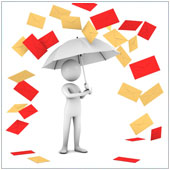
Here’s how you can create filters to reduce junk email.
1. Optimize Outlook’s Junk Email Filter
Outlook has a filter installed to help reduce junk email. It’s usually turned on by default, and set at the lowest setting – imaginatively titled “Low.” This will filter only the most obvious junk email, and will place it into the Junk Email folder (more on that below).
To change the filter’s settings:
- Navigate to the Mail tab and select Home.
- Under the Delete group click Junk, followed by Junk Email Options.
- Select which level of filtering you would like to apply.
Naturally, the higher the setting you choose, the more emails will be sent to the Junk Email folder, junk or otherwise.
2. The Junk Email folder
Any email that fails to get past the Junk Filter is sent to the Junk Email folder. It’s a good idea to check this folder on a regular basis, especially if you have strict settings enabled, as there may be some important emails directed here. If you find an email that isn’t junk, you can drag it from the Junk folder and into the Inbox.
3. Establish Junk Email Filter lists
While turning on filters and monitoring the Junk folder will reduce the number of junk emails, many will still get through. To minimize this even further, you can create a list of trusted email addresses, or one of blocked email addresses. You can create these lists in a number of ways. The easiest is to simply select an email message from a sender and under the Home tab, in the Delete group, select Junk followed by either: Never Block Sender; Email Group or Mailing List, or Block Sender.
You can also manually add addresses, groups, and even websites to your lists. To do this:
- Navigate to Junk Email Options located in the Delete group of the Home tab.
- Select either:
- Safe Senders followed by Add;
- Safe Recipients followed by Add;
- Blocked Senders followed by Add.
- Enter the email address, or group address, from which you would like to allow emails or block. If you have many colleagues that all have the same @user.com address, just add the @user.com part of the address to the list, and Outlook will block or allow emails from any user with that address.
- Select: Also trust email from Customers under the Safe Senders tab to automatically add all of your existing contacts to the Safe Senders list.
These three steps combined should go a long way toward reducing the number of junk emails you receive. It’s important to note that they will not eliminate junk email completely, and some will always get through. If this happens, you can manually block the senders, and should delete the messages without opening if possible. If you’d like to learn more about how Outlook and Office 365’s other programs can fit into your business, please contact us.

